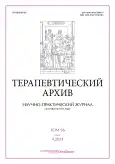Показатели работы миокарда левого желудочка у пациентов с отрицательным результатом пробы при стресс-эхокардиографии с физической нагрузкой
- Авторы: Алехин М.Н.1,2, Радова Н.Ф.3,2, Лещинская С.П.4, Иванов С.И.5
-
Учреждения:
- ФГБУ ДПО «Центральная государственная медицинская академия» Управления делами Президента РФ
- ФГБУ «Центральная клиническая больница с поликлиникой» Управления делами Президента РФ
- ГБУ ДПО «Центральная государственная медицинская академия» Управления делами Президента РФ
- ФГБОУ ВО «Российский университет медицины» Минздрава России
- ФГБУ «Клиническая больница» Управления делами Президента РФ
- Выпуск: Том 96, № 4 (2024)
- Страницы: 349-355
- Раздел: Оригинальные статьи
- URL: https://journals.rcsi.science/0040-3660/article/view/255112
- DOI: https://doi.org/10.26442/00403660.2024.04.202681
- ID: 255112
Цитировать
Полный текст
Аннотация
Цель. Определить возможности выявления пациентов со значимым поражением коронарного русла с помощью оценки показателей работы миокарда левого желудочка (ЛЖ), несмотря на полученный отрицательный результат пробы при стресс-эхокардиографии (стресс-ЭхоКГ) с физической нагрузкой.
Материалы и методы. В исследование включены 79 пациентов с предполагаемой или подтвержденной ранее ишемической болезнью сердца, из них 47 мужчин (59%), у которых получен отрицательный результат пробы при проведении стресс-ЭхоКГ с физической нагрузкой с использованием тредмила. С помощью методики построения кривых «давление–деформация» в покое и на максимуме нагрузки рассчитывали индекс глобальной работы (GWI), глобальную конструктивную работу (GCW), глобальную потерянную работу, эффективность глобальной работы (GWE).
Результаты. При схожих систолическом артериальном давлении и фракции выброса ЛЖ между контрольной группой и группой пациентов с однососудистым поражением коронарных артерий на максимуме нагрузки выявлена достоверная разница в GWI, GCW и GWE. У пациентов с многососудистым поражением коронарных артерий GWI и GCW на максимуме нагрузки также значимо отличались от контрольной группы.
Заключение. При проведении стресс-ЭхоКГ с физической нагрузкой с получением отрицательного или недостоверного результата пробы может быть рекомендована оценка показателей работы миокарда ЛЖ для более точной диагностики ишемической болезни сердца.
Полный текст
Открыть статью на сайте журналаОб авторах
Михаил Николаевич Алехин
ФГБУ ДПО «Центральная государственная медицинская академия» Управления делами Президента РФ; ФГБУ «Центральная клиническая больница с поликлиникой» Управления делами Президента РФ
Автор, ответственный за переписку.
Email: mike.nikolaich@yandex.ru
ORCID iD: 0000-0002-9725-7528
д-р мед. наук, проф. каф. терапии, кардиологии и функциональной диагностики с курсом нефрологии, зав. отд-нием функциональной диагностики
Россия, Москва; МоскваНаталья Федоровна Радова
ГБУ ДПО «Центральная государственная медицинская академия» Управления делами Президента РФ; ФГБУ «Центральная клиническая больница с поликлиникой» Управления делами Президента РФ
Email: mike.nikolaich@yandex.ru
ORCID iD: 0000-0001-8085-3166
канд. мед. наук, доц. каф. терапии, кардиологии и функциональной диагностики с курсом нефрологии, врач отд-ния функциональной диагностики
Россия, Москва; МоскваСветлана Павловна Лещинская
ФГБОУ ВО «Российский университет медицины» Минздрава России
Email: mike.nikolaich@yandex.ru
ORCID iD: 0009-0004-4482-990X
студентка
Россия, МоскваСергей Игоревич Иванов
ФГБУ «Клиническая больница» Управления делами Президента РФ
Email: mike.nikolaich@yandex.ru
ORCID iD: 0000-0002-6768-1045
канд. мед. наук, врач отд-ния кардиологии
Россия, МоскваСписок литературы
- Russell K, Eriksen M, Aaberge L, et al. A novel clinical method for quantification of regional left ventricular pressure-strain loop area: a non-invasive index of myocardial work. Eur Heart J. 2012;33(6):724-33. doi: 10.1093/eurheartj/ehs016
- Ilardi F, D'Andrea A, D'Ascenzi F, et al. Myocardial Work by Echocardiography: Principles and Applications in Clinical Practice. J Clin Med. 2021;10(19):4521. doi: 10.3390/jcm10194521
- Sabatino J, De Rosa S, Leo I, et al. Prediction of Significant Coronary Artery Disease Through Advanced Echocardiography: Role of Non-invasive Myocardial Work. Front Cardiovasc Med. 2021;8:719603. doi: 10.3389/fcvm.2021.719603
- Boe E, Russell K, Eek C, et al. Non-invasive myocardial work index identifies acute coronary occlusion in patients with non-ST-segment elevation-acute coronary syndrome. Eur Heart J Cardiovasc Imaging. 2015;16(11):1247-55. doi: 10.1093/ehjci/jev078
- Российское кардиологическое общество. Стабильная ишемическая болезнь сердца. Клинические рекомендации 2020. Российский кардиологический журнал. 2020;25(11):4076 [Russian Society of Cardiology (RSC). 2020 Clinical practice guidelines for Stable coronary artery disease. Russian Journal of Cardiology. 2020;25(11):4076 (in Russian)]. doi: 10.15829/29/1560-4071-2020-4076
- Borrie A, Goggin C, Ershad S, et al. Noninvasive Myocardial Work Index: Characterizing the Normal and Ischemic Response to Exercise. J Am Soc Echocardiogr. 2020;33(10):1191-200. doi: 10.1016/j.echo.2020.05.003
- Edwards NFA, Scalia GM, Sabapathy S, et al. Resting global myocardial work can improve interpretation of exercise stress echocardiography. Int J Cardiovasc Imaging. 2021;37(8):2409-17. doi: 10.1007/s10554-021-02216-0
- Нагрузочные тесты в клинической практике. Под ред. С.Ю. Бартош-Зеленой. СПб.: АРГУС, 2018 [Bartosh-Zelenaya SYu, eds. Nagruzochnyie testy v klinicheskoi praktike. Saint Petersburg: ARGUS, 2018 (in Russian)].
- Patel MR, Calhoon JH, Dehmer GJ, et al. ACC/AATS/AHA/ASE/ASNC/SCAI/SCCT/STS 2017 Appropriate Use Criteria for Coronary Revascularization in Patients With Stable Ischemic Heart Disease: A Report of the American College of Cardiology Appropriate Use Criteria Task Force, American Association for Thoracic Surgery, American Heart Association, American Society of Echocardiography, American Society of Nuclear Cardiology, Society for Cardiovascular Angiography and Interventions, Society of Cardiovascular Computed Tomography, and Society of Thoracic Surgeons. J Am Coll Cardiol. 2017;69(17):2212-41. doi: 10.1016/j.jacc.2017.02.001
- Lang RM, Badano LP, Mor-Avi V, et al. Recommendations for cardiac chamber quantification by echocardiography in adults: an update from the American Society of Echocardiography and the European Association of Cardiovascular Imaging. J Am Soc Echocardiogr. 2015;28(1):1-39.e14. doi: 10.1016/j.echo.2014.10.003
- Pellikka PA, Arruda-Olson A, Chaudhry FA, et al. Guidelines for Performance, Interpretation, and Application of Stress Echocardiography in Ischemic Heart Disease: From the American Society of Echocardiography. J Am Soc Echocardiogr. 2020;33(1):1-41.e8. doi: 10.1016/j.echo.2019.07.001
- Edwards NFA, Scalia GM, Shiino K, et al. Global Myocardial Work Is Superior to Global Longitudinal Strain to Predict Significant Coronary Artery Disease in Patients With Normal Left Ventricular Function and Wall Motion. J Am Soc Echocardiogr. 2019;32(8):947-57. doi: 10.1016/j.echo.2019.02.014
- Edwards NFA, Scalia GM, Putrino A, et al. Myocardial work and left ventricular contractile reserve during stress echocardiography: An angiographic validation. Echocardiography. 2021;38(10):1711-21. doi: 10.1111/echo.15194
- Lin J, Wu W, Gao L, et al. Global Myocardial Work Combined with Treadmill Exercise Stress to Detect Significant Coronary Artery Disease. J Am Soc Echocardiogr. 2022;35(3):247-57. doi: 10.1016/j.echo.2021.10.009
Дополнительные файлы









